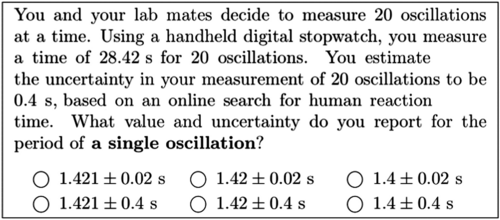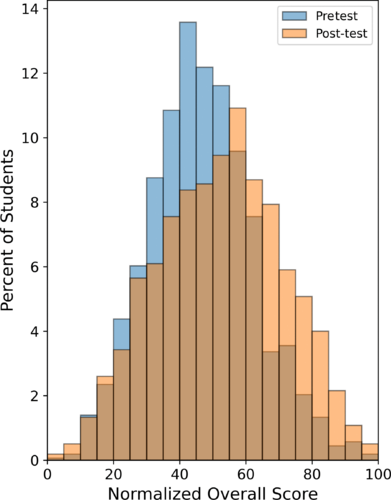Developed by Michael Vignal, Gayle Geschwind, Marcos D. Caballero, Heather Lewandowski
| Purpose | To determine how students handle measurement uncertainty across ten different areas of this subject in intro to upper-level undergraduate physics laboratory courses. |
|---|---|
| Format | Pre/post, Multiple-choice, Multiple-response, Short answer |
| Duration | N/A min |
| Focus | Lab skills (Measurement Uncertainty) |
| Level | Upper-level, Intermediate, Intro college |
Example question from the SPRUCE:

SPRUCE Implementation and Troubleshooting Guide
Everything you need to know about implementing the SPRUCE in your class.
Login or register to download the implementation guide.
more details
This is the second highest level of research validation, corresponding to at least 5 of the validation categories below.
Research Validation Summary
Based on Research Into:
- Student thinking
Studied Using:
- Student interviews
- Expert review
- Appropriate statistical analysis
Research Conducted:
- At multiple institutions
- By multiple research groups
- Peer-reviewed publication
SPRUCE was developed in a multi-stage process. First, instructor interviews were conducted to determine the areas of measurement uncertainty important to them. Next, the assessment was created and went through several rounds of iterations with beta testing and student interviews. Finally, a novel scoring scheme was developed. Research has detailed student understanding of comparing measurements with uncertainty, showing a difference in how they respond to two isomorphic questions with different representations.
References
- G. Geschwind, M. Vignal, M. D. Caballero, and H. Lewandowski, Using a research-based assessment instrument to explore undergraduate students’ proficiencies around measurement uncertainty in physics lab contexts, Phys. Rev. Phys. Educ. Res. 20 (2) 020105 (2024).
- G. Geschwind, M. Vignal, M. D. Caballero, and H. Lewandowski, Evidence for validity and reliability of a research-based assessment instrument on measurement uncertainty, Phys. Rev. Phys. Educ. Res. 20 (2) 020125 (2024).
- G. Geschwind, M. Vignal, and H. Lewandowski, Representational differences in how students compare measurements, presented at the Physics Education Research Conference 2023, Sacramento, CA, 2023.
- B. Pollard, R. Hobbs, R. Henderson, M. Caballero, and H. Lewandowski, Introductory physics lab instructors’ perspectives on measurement uncertainty, Phys. Rev. Phys. Educ. Res. 17 (1), 010133 (2021).
- M. Vignal, G. Geschwind, B. Pollard, R. Henderson, M. D. Caballero, and H. Lewandowski, Survey of physics reasoning on uncertainty concepts in experiments: An assessment of measurement uncertainty for introductory physics labs, Phys. Rev. Phys. Educ. Res. 19 (2) 020139 (2023).
- M. Vignal, K. Rainey, B. Wilcox, M. Caballero, and H. Lewandowski, Affordances of Articulating Assessment Objectives in Research-based Assessment Development, presented at the Physics Education Research Conference 2022, Grand Rapids, MI, 2022.
We don't have any translations of this assessment yet.
If you know of a translation that we don't have yet, or if you would like to translate this assessment, please contact us!
| Typical Results |
|---|
Typical scores are about 50% overall, with varying distributions for scores within each assessment objective. Typical scores from Geschwind et al. 2024:
Pretest (blue) and post-test (orange) overall scores on SPRUCE normalized to 100. In aggregate, students improve from pretest to post-test, as can be seen by the clear shift in the histogram. The distributions themselves are considered normal, with skewness and kurtosis levels for both pre- and post-test distributions well within the limits of normality and Anderson-Darling tests showing that both distributions are normal to a significance level of 1.0%. The ranges of scores show that SPRUCE does not suffer from ceiling or floor effects in the overall score. |
The latest version of the SPRUCE, released in 2023, is version 1. Several pilot versions were tested in 2022.




